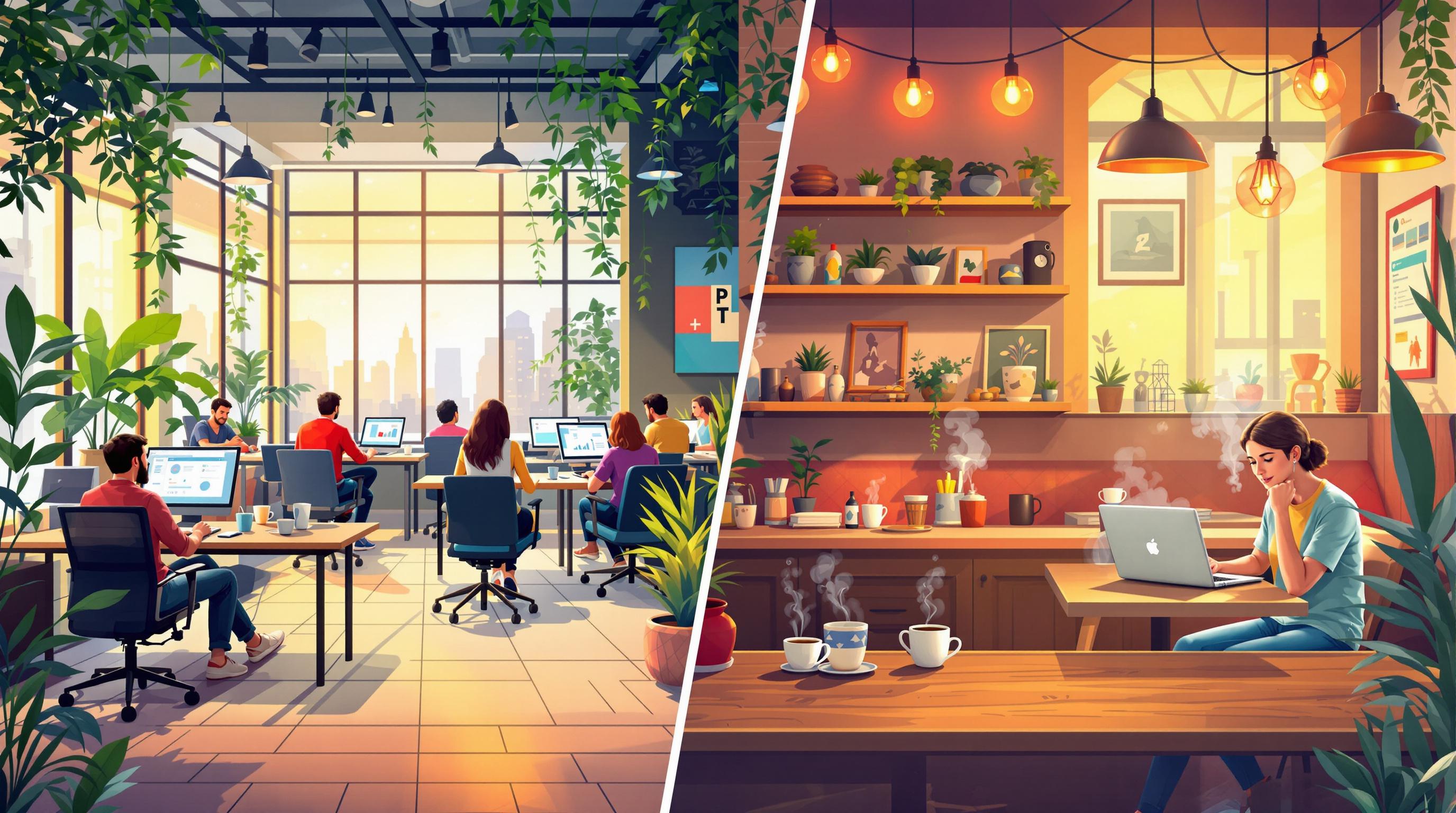Coworking spaces and cafes are two popular workspace options for digital nomads. Here’s a quick breakdown to help you decide:
- Coworking Spaces: Offer reliable internet, ergonomic furniture, quiet zones, and professional amenities like meeting rooms and networking events. Costs range from $200–$500/month or $25–$50/day.
- Cafes: Provide a casual atmosphere, flexible hours, and a chance to experience local culture. However, WiFi and seating may be unreliable. Daily expenses average $18–$27.
Quick Comparison
| Feature | Coworking Spaces | Cafes |
|---|---|---|
| Internet Quality | Reliable, high-speed, with backups | Varies, often unreliable |
| Workspace Setup | Ergonomic desks, quiet zones | Basic tables and chairs |
| Cost Structure | $200–$500/month or $25–$50/day | $18–$27/day for food/drinks |
| Noise Level | Controlled, quiet zones available | Noisy, especially during peak hours |
| Networking | Structured events, professional ties | Casual, unpredictable interactions |
| Power Access | Ample outlets | Limited, often hard to find |
| Privacy | Meeting rooms, private booths | Little to no privacy |
Choose coworking spaces for focus, professional tools, and networking. Opt for cafes if you prefer flexibility and a creative vibe. Many digital nomads use both for different tasks.
Coworking Spaces: Work-Focused Environment
Coworking spaces cater to the needs of remote professionals by providing the infrastructure and community support required for different work styles.
Standard Equipment and Services
Modern coworking spaces come equipped with everything you need to get work done. Think high-speed internet, ergonomic desks, and meeting rooms. Plus, they often include extras like mail services and 24/7 access.
| Essential Features | Additional Services |
|---|---|
| High-speed internet | 24/7 access |
| Ergonomic workstations | Printing and scanning |
| Meeting rooms | Mail handling |
| Private phone booths | Storage lockers |
| Backup power systems | Reception services |
These facilities are designed to provide a consistent, professional environment for uninterrupted work [1].
Community and Business Connections
Coworking spaces aren’t just about desks - they’re about connections. Spaces like WeWork and Regus organize events such as workshops, networking mixers, and skill-sharing sessions. These events can be a goldmine for digital nomads looking to build their network and grow professionally [2].
Price and Membership Types
Membership options are flexible, tailored to fit different work habits. While coworking spaces are pricier than cafes, the dedicated amenities and professional environment make them a worthwhile investment for many.
| Membership Type | Typical Access |
|---|---|
| Hot Desk | Use any available desk |
| Dedicated Desk | Reserved workspace |
| Private Office | Enclosed private space |
| Virtual Office | Mail handling and meeting use |
For those who need flexibility, daily passes are a great option. Longer-term memberships often come with discounts and added perks [1].
Coworking spaces offer a structured, professional setting, but if you’re after something more casual, cafes might be the way to go. We’ll dive into that next.
Cafes: Flexible Work Setting
Cafes, often found in central or trendy neighborhoods, serve as accessible and informal workspaces for digital nomads. Their relaxed vibe can spark creativity while giving visitors a taste of local culture through unique decor and cuisine.
Setting and Location Benefits
Cafes come with several perks that make them attractive to remote workers:
| Cafe Environment Benefits | Description |
|---|---|
| Location Accessibility | Conveniently located with good transport options |
| Atmosphere | Relaxed and conducive to creative thinking |
| Time Flexibility | No need for memberships or fixed schedules |
| Local Immersion | A chance to connect with local culture through food and ambiance |
Daily Expenses
Cafes don’t require memberships, but regular purchases are expected. A typical day of working at a cafe might cost between $18 and $27, covering coffee and light meals. While affordable for occasional visits, it can become pricey for daily use.
| Item | Average Cost |
|---|---|
| Coffee/Tea (2-3 per day) | $8-12 |
| Light Meals/Snacks | $10-15 |
| Total Daily Expense | $18-27 |
Common Problems
Cafes, though inviting, come with their own set of challenges. WiFi can be unreliable, especially during busy hours, and the constant background noise - customers chatting, music playing - can make it hard to concentrate. Essential work amenities are often missing:
- Limited power outlets
- Uncomfortable seating
- Small tables
- No quiet zones for focused work
Experienced remote workers suggest visiting during quieter times and using noise-canceling headphones to stay productive [1].
While cafes provide a casual and creative environment, their downsides highlight the more structured benefits of coworking spaces, making it worth comparing the two options.
sbb-itb-574d71c
Direct Comparison: Coworking vs. Cafes
Coworking spaces and cafes offer different experiences for digital nomads. Let’s break down how they compare on factors that matter most for remote work, including functionality, cost, and overall work environment.
Feature Comparison Chart
Here’s a side-by-side look at key differences between coworking spaces and cafes:
| Feature | Coworking Spaces | Cafes |
|---|---|---|
| Internet Quality | High-speed, reliable connection with backups | Speeds vary, often unreliable during busy times |
| Workspace Setup | Ergonomic furniture, dedicated desks, various options | Basic tables and chairs, limited choices |
| Professional Amenities | Printers, scanners, meeting rooms, phone booths | Typically unavailable |
| Cost Structure | Monthly memberships ($200-500), day passes ($25-50) | Pay-per-use ($18-27 daily for food/drinks) |
| Noise Level | Controlled, with quiet zones | Noisy, especially at peak times |
| Hours of Operation | Extended hours (usually 6 AM - 10 PM) | Limited to business hours |
| Networking | Structured events, professional communities | Casual, unpredictable interactions |
| Power Access | Plenty of outlets at workstations | Few outlets, often a scramble to find one |
| Privacy | Meeting rooms, phone booths available | Little to no privacy |
| Additional Services | Mail handling, lockers, kitchen facilities | Basic restrooms only |
Coworking spaces cater to professionals who need a reliable setup, offering consistent internet, quiet zones, and amenities like meeting rooms and networking events. Cafes, on the other hand, are better for those who want a casual, flexible workspace and don’t require advanced tools or privacy.
As one remote work expert puts it:
Fast, reliable internet is crucial for most remote workers [4]
Coworking spaces are ideal for digital nomads who prioritize a professional environment with dependable internet, private spaces, and networking opportunities. Cafes appeal to those who prefer a more relaxed, short-term setup with a touch of local culture and fewer technical demands.
The right choice depends on your work style, budget, and specific needs. Let’s dive into how to pick the best workspace for you.
Making Your Workspace Choice
Choosing between coworking spaces and cafes depends on your work habits, budget, and lifestyle. Here’s a breakdown of the main factors to help you decide.
Work Habits Analysis
Your work style plays a big role in determining the best environment for you. Here’s how the two options compare:
| Work Pattern | Coworking Space | Cafe |
|---|---|---|
| Focus Required | Quiet zones, fewer distractions | Background noise, lively atmosphere |
| Meeting Frequency | Private rooms, professional setting | Limited privacy, casual vibe |
| Collaboration Needs | Networking opportunities, shared spaces | Informal, chance interactions |
| Tech Requirements | Reliable internet, plenty of outlets | Unpredictable Wi-Fi, fewer power sources |
For roles like developers or analysts, coworking spaces offer the focused setup and strong infrastructure needed. On the other hand, writers and designers often enjoy the creative boost from a cafe’s atmosphere and changing scenery [3].
But work habits aren’t the only factor - your budget and travel logistics matter too.
Cost and Travel Factors
Here’s a look at the typical costs:
- Coworking Monthly Cost: $200–500 for membership
- Cafe Daily Spending: $18–27 on food and drinks × 20 workdays = $360–540 per month
Location is another key factor. A hybrid approach - using both coworking spaces and cafes - works well for many digital nomads, balancing cost and convenience.
Finally, your workspace choice also impacts your lifestyle and daily routine.
Work-Life Mix
Your workspace influences how you structure your day and maintain productivity. Here’s how coworking spaces and cafes compare:
| Aspect | Coworking Spaces | Cafes |
|---|---|---|
| Daily Structure | Encourages routine and work-life balance | Flexible, fits a nomadic lifestyle |
| Community | Networking and professional connections | Casual socializing and cultural experiences |
| Amenities | Full facilities simplify your day | Minimal, focused on mobility |
| Commitment | Dedicated and professional | Low-commitment, adaptable to changing schedules |
Many digital nomads use both options: coworking spaces for focused, structured workdays and cafes for lighter tasks or creative projects [3][4].
Conclusion
Key Differences Between Coworking Spaces and Cafes
When deciding between coworking spaces and cafes, digital nomads should focus on factors that directly affect their productivity and overall work experience. Here’s a quick comparison:
| Aspect | Coworking Spaces | Cafes |
|---|---|---|
| Environment | Designed for work, organized | Relaxed, unpredictable |
| Infrastructure | Reliable internet, ample outlets | Spotty WiFi, limited power access |
| Networking | Opportunities for collaboration | Casual conversations only |
| Focus | Quiet and distraction-free zones | Background noise, open setting |
Use this breakdown to weigh your options and choose what works best for your specific needs.
Practical Tips for Choosing Your Workspace
-
Test Both Environments: Try short-term coworking passes and spend time working in cafes. Pay attention to how each setting influences your focus, productivity, and overall satisfaction [1] [2].
-
Combine Both Options: Use coworking spaces for tasks requiring deep focus or hosting professional meetings. Opt for cafes when working on creative projects or handling lighter tasks. This mix can help you manage issues like unreliable internet or noisy environments [3].
Ultimately, your workspace should support your goals and suit your work habits. By staying open to adjustments, you can maintain both productivity and a sense of satisfaction [4].



